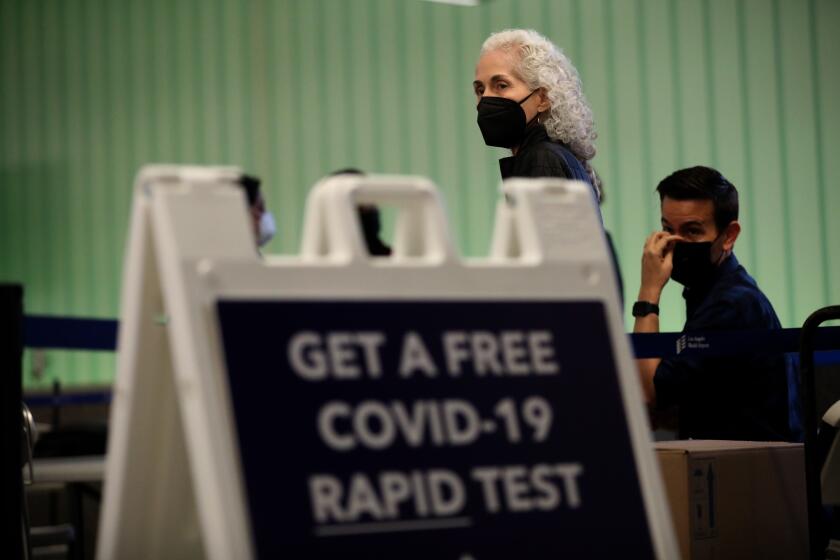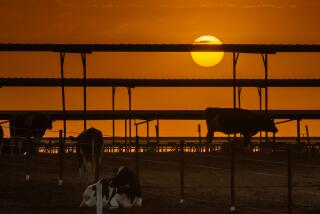Omicron was in California weeks ago, before officials raised alarms, water sample suggests

- Share via
The Omicron strain of the coronavirus was detected in California’s wastewater last month, even before the World Health Organization declared it a “variant of concern,” lab data suggest.
In a statement to The Times, the California Department of Public Health said that a sample of wastewater collected in Merced County on Nov. 25 contained a mutation that suggests the Omicron variant was present in California at that time.
That’s one day after South African scientists informed the World Health Organization of the new variant and a day before the WHO gave it the name Omicron and declared it the newest coronavirus variant of concern.
The finding reinforces observations that scientists have made in recent weeks: that Omicron was rapidly spreading across the world before global health officials were aware it existed.
There are other examples that indicate Omicron was in California before the WHO gave the variant its Greek-letter designation and raised the alarm on Nov. 26.
The number of cases associated with the new variant rose to double digits this week, including a case in L.A. County possibly resulting from local transmission.
The first Omicron case identified in the U.S., in a San Francisco resident, returned home Nov. 22 from a trip to South Africa and became symptomatic on or around Nov. 25 — Thanksgiving Day.
Los Angeles County’s first verified Omicron case was detected in a traveler who also returned on Nov. 22 after a trip to South Africa via London.
Sampling wastewater for coronavirus-related particles is being used to track pandemic trends.
In California, several groups of scientists are monitoring wastewater for coronavirus samples, including experts affiliated with Stanford University, UC Berkeley, UC Davis, UC Merced, UC San Diego and the state Department of Public Health.
A Stanford group reported to the state that it detected a mutation suggestive of — but not specific for — Omicron in wastewater not only in Merced County, but also Sacramento County, the Department of Public Health said in its statement.
The samples were retested and confirmed using a second, more specific lab procedure indicating the variant is likely present in Sacramento and Merced counties, state officials said.
There have been more than a dozen confirmed Omicron cases identified in California, with the latest reported in Santa Clara County on Thursday. Other cases have been detected in Alameda, Los Angeles, San Diego, San Francisco, Yolo and Santa Clara counties.
It’s still far from clear what kind of COVID-19 increase California will see, and the state so far has been doing better than other parts of the country. But officials say they want to be ready.
Although there’s been a scattering of cases, there have been no Omicron outbreaks in the state. Officials have said that early indications are the variant is highly transmissible, but it might not cause as illness as severe as the Delta variant.
The findings come as health officials from a number of California counties say they’re seeing early signs of a rebound in coronavirus cases related to Thanksgiving, which some worry could be the beginning of the state’s fifth COVID-19 surge. Those cases are connected to the Delta variant.
It’s still far from clear whether California will see a significant spike in cases this winter or if the combination of relatively high vaccination rates and various safety rules limits the scope of a surge.
But there are already warning signs.
Statewide, the daily average of newly reported infections has risen more than 30% since before Thanksgiving. The number of Californians hospitalized with COVID-19 also has climbed during that time, interrupting weeks of mostly steady declines.
In Los Angeles County, weekly coronavirus case rates have climbed by 33% over the last two weeks, sending the nation’s most populous county back into the worst coronavirus transmission tier, colored red on maps published by the U.S. Centers for Disease Control and Prevention.
Times staff writer Luke Money contributed to this report.
More to Read
Sign up for Essential California
The most important California stories and recommendations in your inbox every morning.
You may occasionally receive promotional content from the Los Angeles Times.













